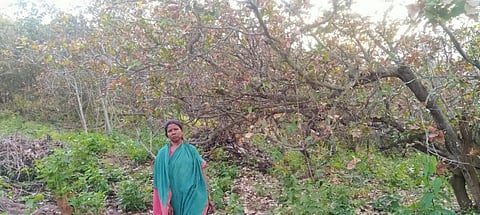

Tea mosquito bugs have attacked acres of cashew crops in Odisha and climate change may be to blame, say experts.
Thousands of cashew growers in Ganjam district have suffered crop loss due to the infestation, according to Sarat Chandra Behera, deputy director of the state horticulture department.
Almost all of the cashew plants Ramesh Sabar, a tribal farmer in Raipada in Odisha’s Ganjam district, had grown in about two-hectares of land dried up without flowering at a time when the cash crop is usually harvested.
Sabar, who lives in Beguniapada block, said:
I harvested a bumper crop during this period last year. But this time, an unknown disease attacked the plants for which the harvest was almost nil.
The tea mosquito bug (Helopeltis antonii) has been around for years but generally infected the cashew plantations in the south Indian states, said Prabhu Charan Lenka, former professor of horticulture of Odisha University Agriculture and Technology (OUAT), Bhubaneswar.
Fruits of plants infected by the bug get a warty appearance and its market value is substantially reduced, said Lenka, one of the consultants of the Directorate of Cashewnut and Cocoa Development (DCCD) under the Union Ministry of Agriculture.
Climate change is one of the reasons behind the geographical shift in the infestation, said experts. Unseasonal rains in the month of December-January in Odisha, when the plants grow with the flowers, and soaring temperature in the subsequent periods may be responsible, said Lenka.
The normal yield of the plant is around four-five quintals per acre, he added. “But it is difficult to expect even one quintal of harvest per acre this time due to the infestation.”
Crops that were not completely destroyed will also suffer quality loss and fetch lower prices as the cashew processing unit will look for high quality kernels, said Subash Panda, a cashew grower in Puri district.
Around 40 per cent cashew plants in the state have been infected by the bug, he said. Ganjam, Gajapati, Rayagada, Nayagarh, Puri, Dhenkanal, Koraput and Kendrapara districts are the worst-hit, he added.
Cashew was planted in around 160,000 hectares of land across the state in 2022. In 2020-21, Odisha produced around 125,000 tonnes of cashew nuts, according to official sources. Cashew is also cultivated by the soil conservation department and state government-owned Odisha Cashew Corporation, apart from private growers.
Odisha is the third-largest state in cashew cultivation, production and processing in the country after Maharashtra and Andhra Pradesh, said Sabat, the former president of Odisha Cashew Growers’ Association. The processors could not export the cashew from the state as these cater to the local demands, he added.